How To Build an In-house B2B Lead Generation System That Repeatedly Generates 10-100 Leads Every Month For Your SaaS, Consulting, or Technology Businesses
Understanding and deploying B2B Lead generation: A Comprehensive Guide
Once you complete this article, lead generation will make complete sense. Learning how to generate leads is a skill that every person should know. It should be a skill that is taught in schools and universities. Unfortunately, there is mass confusion across the industry on basic concepts, so in this article, we will set the record straight and cover:
Examples of actual B2B organic automated lead generation across multiple industries
The Top Reasons Why YOUR lead generation and sales process probably sucks
(For example, you don’t understand how to approach the market using BOFU, MOFU, or TOFU outreach, don’t understand unit economics, etc.)
How to implement a winning lead generation strategy step by step
This article has been written and supported by 15+ years of B2B sales and marketing experience, having worked with over 100+ businesses and selling over $17m in products and services, and these are strategies and tactics that are being used right now, today.
Recent Example of Successful Automated Lead Generation - SaaS & Consulting

Figure 1 shows how we achieved a 68% LinkedIn acceptance rate by utilising a highly targeted profile carefully written for its target audience. 30% of companies responded to the outreach cadences.

Figure 2 shows how we targeted the same audience but split-tested a different outreach cadence, which resulted in a 24% response rate. Interestingly, we still maintained a 67%+ acceptance rate, which means profile optimisation and targeting provide consistent, predictable results.
120+ Leads Generated Organically On Linkedin in 30 Days in 2023 Using B2B Growth Implementation Automation System
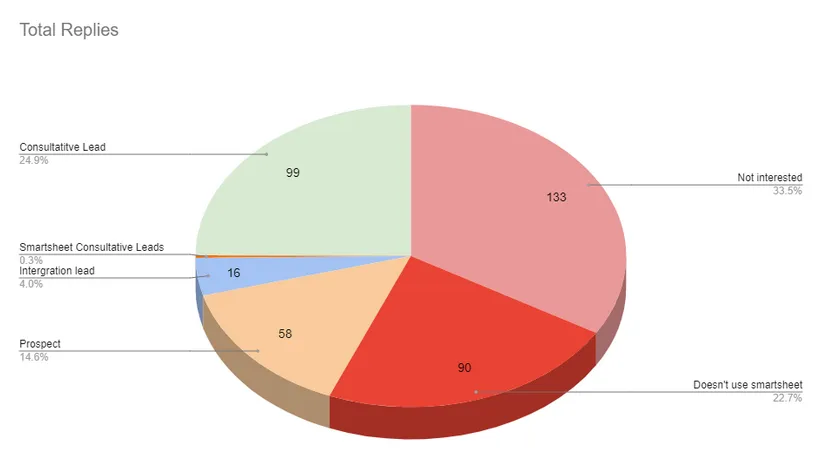
Figure 3 shows a breakdown of responses, with 31.9% of replies resulting in leads.
Recent Example - Software Development

Figure 4 shows a breakdown of niche segments, measuring the exposure lead rate. Here, we can see the exposure lead rate is higher in some segments than others. This gives us a strong indication of where we should focus our outbound marketing efforts.
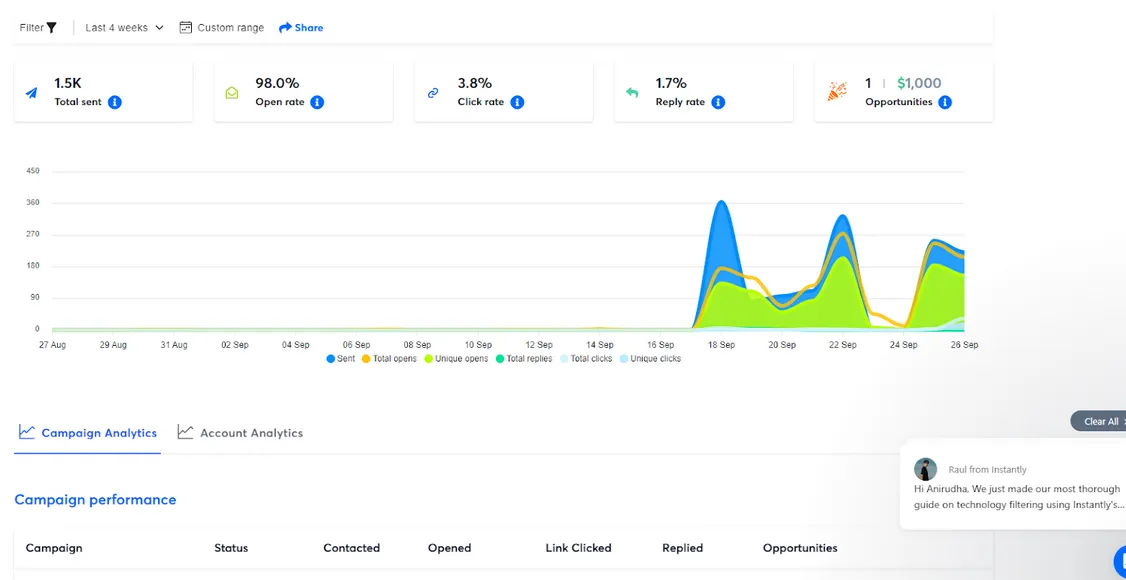
Figure 5 shows an email campaign for an offshore software development company targeting computer software companies in the USA, UK, Europe, NZ & Aus. Offshore software development is among the most oversaturated, highly competitive B2B industries. However, notice how we still achieved a 98% open rate, with a 3.8% click-through rate, a 1.7% reply rate and one lead. This is an excellent example of the B2B Growth Implementation strategies working even in the harshest environments. Highly targeted outreach and messaging will result in a close to 100% open rate.
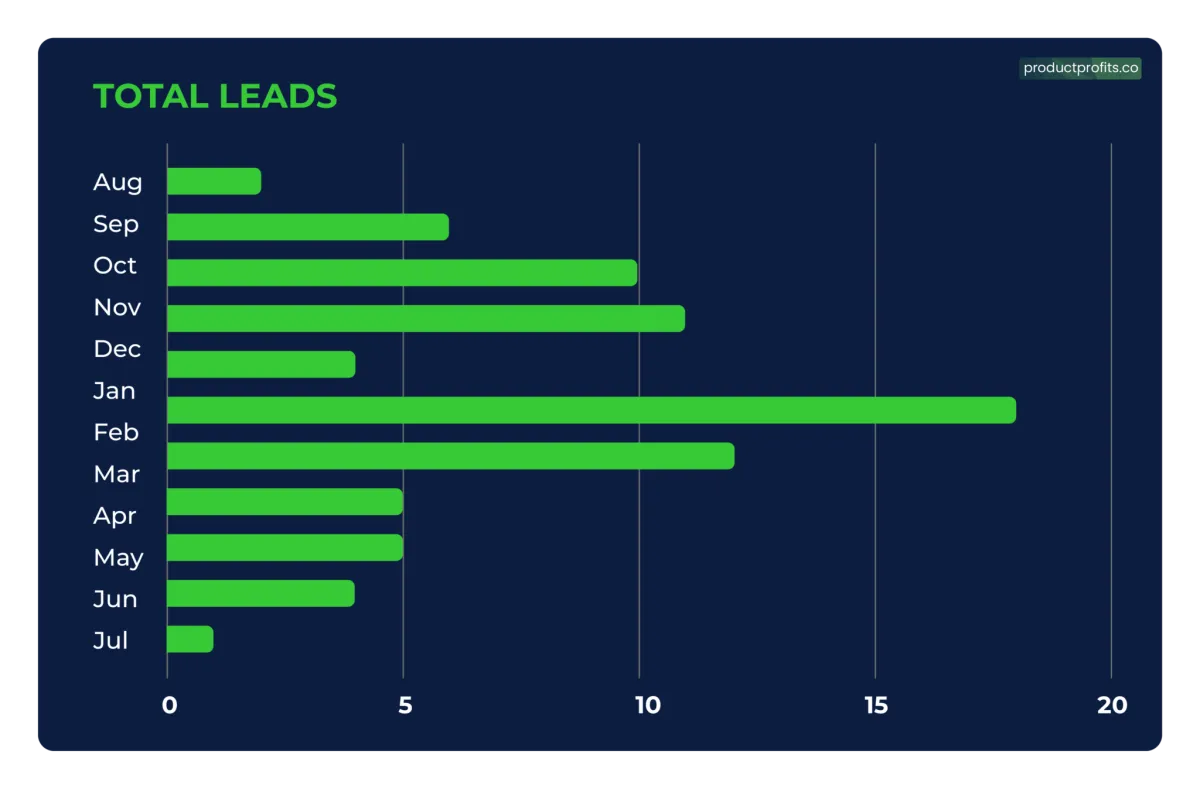
Figure 6, screenshotted at the beginning of June, shows a consistent average of 5-7 monthly leads. These high ticket leads could yield $ 35k- $ 1m in ACV.
Recent Example - Software Development

Figure 7 shows a 3.76% exposure lead rate for a new SaaS offer, a private social media network. October 2022

Figure 8 shows a 5.05% exposure lead rate in November 2022, demonstrating how the exposure lead rate can increase each month.
So What Really Is Lead Generation?
Lead Generation is identifying or creating interest in your product or service. It can be seen as generating interest or tapping into existing interest to solve the problem you provide.
An outbound lead generation strategy is usually the first to deploy for new B2B offers because, compared to your alternatives, it’s more cost-effective than paid advertising and quicker to set up than a full-fledged content marketing strategy.
An organic lead generation campaign can be set up and deployed in a few hours and start generating results in less than a few days.
Here, we see the typical growth phases of a successful B2B business.

In Figure 9, the roadmap for business growth is laid out sequentially. Although it’s listed as step 2 here, You can start your lead generation strategy before solving for product-market fit without a product/product market fit/conversion mechanism or even a website. Lead generation is simply turning a cold prospect into a lead.
Prospects vs. Leads
Why Do So Many People Get This Wrong?
Not Even The Industry Knows The Difference!
Now, here’s where the confusion creeps in. The Industry has it backwards! A lot of mainstream industry players contradict each other.
But one thing that is for sure, as stated by Adobe, is that “many sources fail to clarify and often use the terms interchangeably.”
| Adobe | Leads: Ubiquitous terms used in marketing. However, many sources fail to clarify and often use the terms interchangeably. Source |
| HubSpot | Lead: An individual at the top of the funnel who hasn’t yet been qualified. They might have downloaded content or were contacted by a sales rep via a cold call. Opportunity: A qualified prospect with a high chance of closing. Prospect: A contact qualified as an ideal customer who would consider buying. A lead is an unqualified contact, while a prospect is a qualified contact who has been moved into the sales process. Source |
| Indeed | Lead: A person whom a company has not qualified as an actual sales prospect yet. A company can find new leads in multiple ways, such as contacting names in a phonebook, conducting an internet search, or reaching out to referrals. Source |
| Crunchbase | Lead: Defined by one-way communication. You’ve contacted your lead, but they’ve yet to reply. A lead is always an unqualified contact; you’ve yet to establish a relationship with them. Prospect: Leads that have either engaged with you and indicated they are good candidates for outreach or qualified by your sales team as matching your ideal customer profile. Prospects have likely already engaged with your marketing or sales team and have a high chance of graduating to a qualified sales opportunity. Source |
| Klipfolio | Leads: At the top of the sales funnel in the awareness stage. These users are typically researching a pain point and want to identify possible solutions. Prospect: A person who is in the consideration stage of the sales funnel. They are performing buying tasks such as seeking information about products and comparing them against the requirements they have for the purchase. Sales Opportunity: A prospect that has demonstrated strong engagement and a strong likelihood of making a purchase. Source |
Figure 10 shows definitions of prospects or leads from 5 different companies. Here, we can see industry-wide confusion and misunderstandings of ubiquitous terms.
"Even if a thousand voices tell you you're wrong, if your compass points true north, you're on the right path."
Many companies struggle to build lead generation systems because they don’t even understand what the system is designed to generate.
Indeed: “A person whom a company has not qualified as an actual sales prospect yet. A company can find new leads in multiple ways, such as contacting names in a phonebook.”
Crunchbase: “Somebody who has been contacted, but they are yet to reply.”
That must be why so many people struggle with lead generation.
Thankfully, B2B Growth Implementation is here to debunk the myths and provide a light in the darkness,
So, What are prospects and Leads?
(The actual definition and history of terminology)
Prospects are your prospective customers, and “prospective” in the dictionary means “expected or expecting to be something particular in the future”.
So, for example, let’s say you provide software solutions to dentists, and your targeting looks like this [dentists, North Carolina,1-50, IT managers, affected by new legislation]. If you build a list of these people, these will be your target prospects or prospective customers.
What is prospecting?
Prospecting involves searching for and identifying potential leads for a business’s products or services. It is the first step in the sales process and entails reaching out to potential prospects to gauge their interest and determine if they fit the company’s ideal customer profile. When you are prospecting, you are working through a cold batch of prospects, searching for leads that align with the ideal customer profile.
What are leads?
Once you reach out to your target prospects and they are interested in your product or service, they become a lead.
Now, a lead goes beyond just fitting the criteria. They’re the ones who meet your requirements and show genuine interest in what you’re offering.
Picture this: You reach out to a hundred dentists. Out of those, 30 respond enthusiastically to your marketing message. These thirty individuals are your leads. Your lead conversion rate would be a respectable 30%.
Where do the terms prospects and leads originate from?
The term “prospecting” in sales can be traced back to the California Gold Rush of 1849, where individuals “prospected” for gold by panning through riverbeds for nuggets. In the same way as prospecting or searching through a riverbed panning for gold, you are prospecting or searching through prospects searching for leads.
Similarly, the term “lead” in sales and marketing is reminiscent of the old mining days. In mining, a “lead” signified the presence of a valuable mineral, guiding miners to its source. In sales and marketing, a “lead” denotes a potential customer or client showing interest in a product or service. As miners pursue leads to uncover precious minerals, salespeople chase leads to discover potential sales opportunities.
Now, to be more specific, you reach out to 100 dentists via email. Out of those 100 dentists, 50 of them open your email, and 30 of them become leads. As a result, your exposure lead rate would be 60% because you are counting the number of people who became interested in your office from those who were exposed to your marketing message.
What does exposure lead rate mean?
James Carby-Robinson coined the term exposure lead rate in 2019. It is used to test the effectiveness of your marketing message. We use exposure lead rate to push marketing messages rather than depend on standard lead rate.
If your marketing message needs to be consumed or experienced, it must be more accurate to measure its effectiveness. Why count lead rates based on companies that have not read your message or spoken to you? That’s why we use exposure lead rate.
Prospect > Lead > Opportunity > Proposal
Now, you need to understand the different types of Leads.
It is common to be eager to connect with potential customers. After all, these people are ready to jump on board and embrace your product. But know that not all leads are equal. Some leads are red-hot and willing to sign up. On the other hand, some may have lost interest or need nurturing to reach that level of readiness.
So, let’s jump into their differences and how to “warm up” your leads:
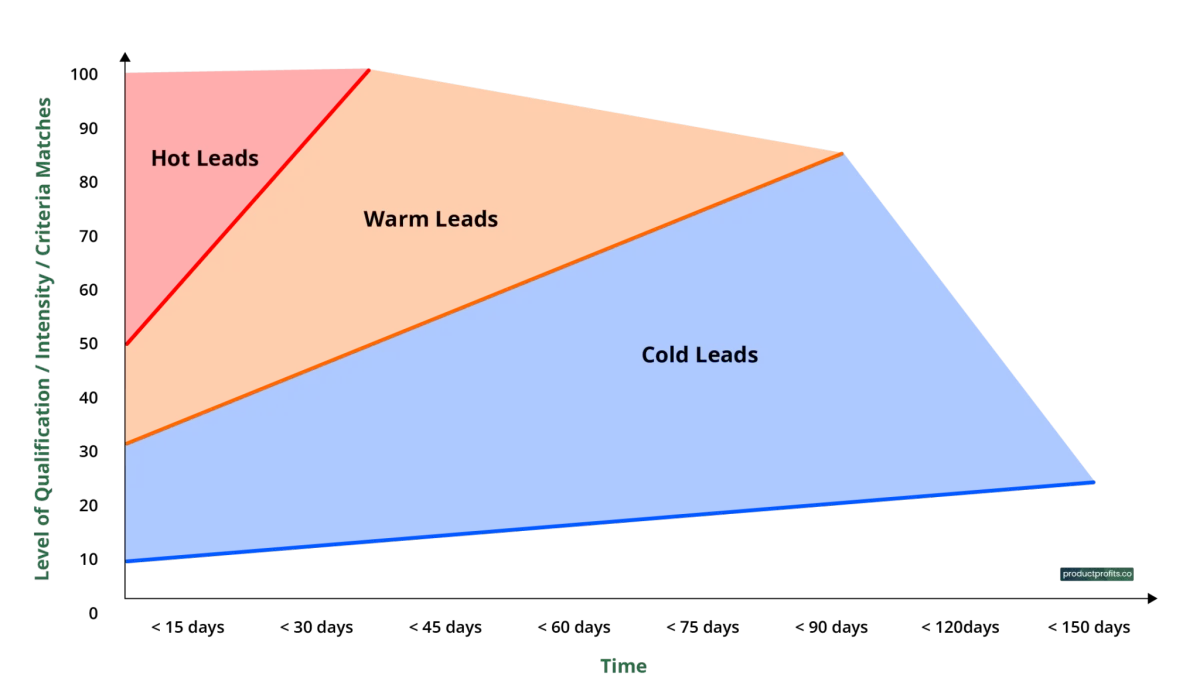
Figure 11 shows a mock-up concept of how leads can be measured.
Hot Lead - These are your priority
These are potential customers who are interested, actively engaged, and ready to make a purchase call. They come with precise needs and a specific timeline. This is what makes them a top priority for your sales team. The term “hot” refers to the time from the last signal and the intensity of the desire.
So, the next time you find yourself with a hot lead, know it's time to buckle down. Your goal should be to provide an exceptional sales experience and close the deal.
Warm Lead - Keep these guys bubbling and peppered with content
These individuals have displayed interest in and engaged with your business. They might've attended webinars, reviewed white papers, or interacted with your social media content.
Cold Leads - Keep in touch with these regularly
These potential customers may have once shown interest in your company or product. Alas, somewhere along the line, they lose contact or don't engage. It could be due to a lack of prompt communication or simply because their needs have shifted. Sales professionals might describe these leads as "gone cold." The good news is that you can revive cold leads using nurture strategies and middle-of-the-funnel content.
Then, You will need to Understand How to Segment Your Leads.
We Suggest Effective Segmentation Methods based on identifying your lead's thought stage
What do your prospects currently believe?
Effective lead segmentation is the cornerstone of accurate selling. Doing it right helps you connect with potential customers at the right moment in their buying journey with the proper conversation or content.
One of the most crucial parts of lead segmentation is the different stages of the funnel.
There is also industry confusion with “The stages of the funnel.”
You can categorise leads into three stages. Each stage represents a unique phase in their buying journey:
Top of the Funnel (TOFU)
Middle of the Funnel (MOFU)
Bottom of the Funnel (BOFU)
When you determine which stage a specific lead falls under, you can personalise your approach and deliver the "right" content and "messages" to meet their particular needs and readiness to purchase.
Now, here's where it gets confusing.
The top of the funnel can mean two things:
The prospect figuratively enters your funnel. For example, if the prospect enters the funnel through your social media ads, it could be called a top-of-the-funnel lead. The top of the funnel could be referred to as the entry/exposure points to your funnel.
OR and as we prefer:
Where the prospect is mentally identified as being at the top of the funnel in their buyer's journey, based on the type of content they have interacted with, or based on questions they have asked, or signals they have given us.
It's more effective to rank leads based on 2) where they appear on their buyer's journey because it allows you to provide them with content that explicitly matches their current psychological stage
For example, you don't want to send discount vouchers (BOFU) to someone who has just come across your company and downloaded an ebook (TOFU) because they have yet to be ready to buy; they are likely just browsing.
Now, here’s where it gets interesting. Once you have mapped out all of your target prospects or TAM based on where they are in their life journey and how it relates to the transformation you provide, you can begin to quantity the data pool you will be extracting from.
You Must Understand How To Analyze Your Total Addressable Market and Make Market Assumptions
You must make market assumptions on where you believe your target market to be mentally. Depending on where your prospects or leads are depends on the sales experience you provide.
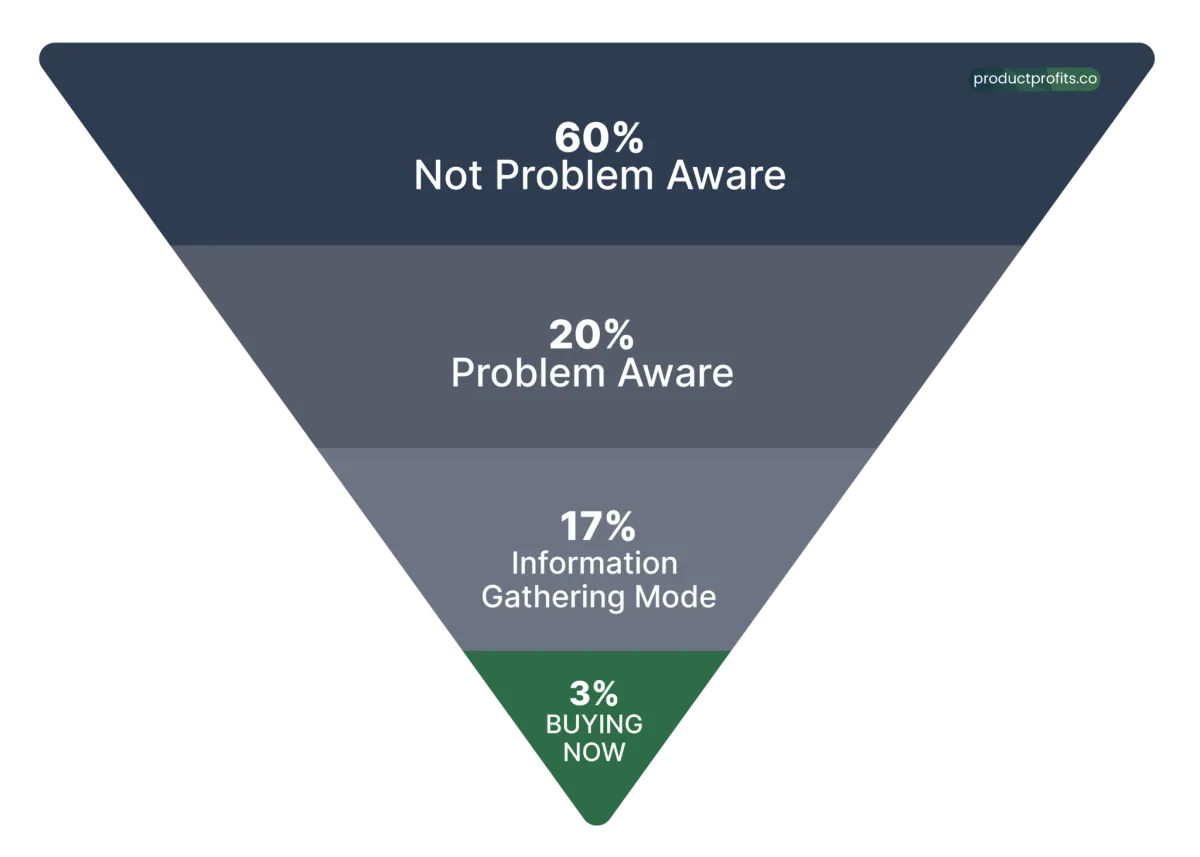
Figure 12 shows the more significant market formula.
Top of the Funnel (TOFU): Awareness (no problem aware or problem aware)
This refers to prospects or leads that need to be more problem-aware or just becoming problem-aware. They will engage in a top-of-the-funnel piece of content or ask a TOFU question.
These people are aware that there may be something more on the horizon. However, they're not experiencing the burning pain of their problems yet.
How to capture TOFU leads in lead generation.
Once a prospect becomes a lead, you will want to quickly identify where they are in their buyer's journey so you can provide them with the right conversational frame and sales experience.
This is done by examining external signals through information you can find online, hear from word-of-mouth, or through discovery questions. So when the prospect responds via Linkedin or email, you can ask the prospect a qualifying question to gauge where they are.
A real-life example of a TOFU Prospect:
One of our clients offers software development services. When we send out our TOFU cold emails offering TOFU content, We regularly receive messages from prospects responding to our TOFU content [how to solve your customer's most significant problem by using our solution],
At first glance, we identify these prospects as top-of-the-funnel leads. And that's because they must know the problem or at least sense a better approach. They may be beginning information-gathering mode but have yet to be ready to consider solutions. They are still becoming problem and solution-aware.
Notice how he didn’t ask for a call but instead asked for more information. In this scenario, offering a discovery call would not be suitable because that is offered to MOFU - BOFU prospects.
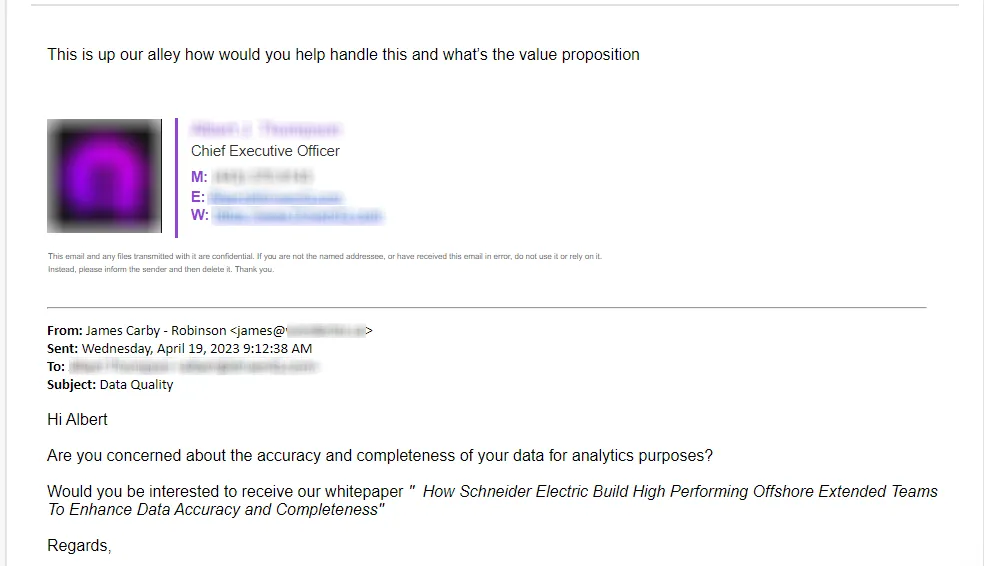
Figure 13 shows a top-of-the-funnel lead responding to a TOFU offer. He is problem-aware because he responds, “How would you help handle this?” referring to his problem. Notice how we asked two questions - 1) are you concerned with this problem, and 2) would you like to receive a copy of this guide?
We should respond with a solid sales letter in video and article format so the lead can consume the information in their chosen format.
The sales letter or argument should include the correct educational elements to educate the prospect, overcome common objections before they arise, and present rational options and solutions.
Middle of the Funnel (MOFU): Consideration - Information gathering mode
In the middle of the funnel, leads actively consider their options.
At this stage, MOFU leads have realised their problem and started exploring potential solutions, which is where your product or service comes into play.
Most companies make the mistake of focusing more on their “competitors” than “competing solutions”. Most likely, the alternative solutions to address your target market's problem will be a more significant threat to your deals than your direct competitors.
Suppose you find yourself losing deals regularly to your competitors. In that case, you’re either competing for a business far down the funnel (BOFU), in an enterprise market, or in a market with only a few big players.
Let’s say you’re a doctor, and a patient walks into your office. Your patient might accept they have a problem and be considering all of the different options for treatment. They could be natural remedies like water fasting, juice detoxes, meditation, and visualisation. Or they could be commercial remedies, such as operations, medications, antibiotics and other things.
To convert the middle-of-the-funnel prospects., you will need to provide plenty of comparison articles and case studies demonstrating the success of the transformation.
If we refer back to our Product-Market Fit guide, prospects are considering the ideal mechanism to achieve their transformation goals. So, you have already established that the transformation is desired, and now they are deciding on the mechanism we will use to get there.
Here’s another example. Let’s say you sell recruitment services. Now, your leads would have the option of using a recruitment agency, hiring directly, using a job board, etc. It means you're competing against "other ways" of solving the problem rather than now with other recruitment agencies.
It’s essential to nurture these connections. Focus on providing more detailed information and case studies. You can also share notable examples of how your offering can address their challenges. Opt for personalised and targeted content to build trust, overcome objections, and position your business as the ideal solution.
What is a discovery call?
Before diving into the demo, you should conduct a short "discovery" call for high ticket sales. This introductory call between yourself and the prospect should be an initial assessment of the prospect's current situation.
Imagine you, the doctor, the expert in your field, and a patient in your office experiencing a problem. You will need to ask a range of questions to understand the patient's current condition before you write them a prescription. This is the same frame as the discovery call.
You will need to know information such as:
How long have they been experiencing the problem?
What have they already tried to solve the problem?
What are the symptoms?
What bad things do they think will happen if this problem is solved?
Do they have medical insurance? Can they cover the cost of a lengthy procedure?
Are they prepared to have an operation? What are their options?
If you identify the prospect as a TOFU - MOFU lead, you must provide valuable, educational content that addresses their pain points or opens their eyes.
A top-of-the-funnel lead could be considered as somebody who should consider being vaccinated. Vaccination prevents problems from occurring; your content is the vaccination they should consume. They need to be aware of the problem, how to prevent it, and symptoms that show they have a problem, and be aware of all possible treatments.
Content will need to be written around symptoms of the problem and how they can identify and solve their problem.
The idea is to influence them to realise the need for your product or service.
In short, you'll need to capture their attention and bring them closer to recognising the value of your product or service.
Remember, at this point, they may need to be fully aware of their problem. You must ignite their interest and position yourself as a trusted authority in the industry.
We use something known as "sales letters," disguised as articles or blogs, that are written in a specific order designed to take prospects from the top of the funnel to the bottom of the funnel.
Bottom of the Funnel (BOFU): Decision
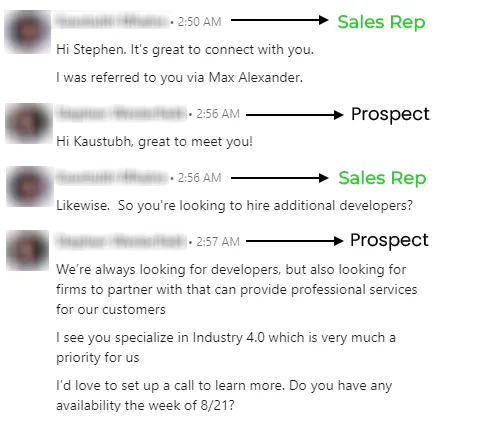
Figure 14 shows a simple LinkedIn social selling conversation resulting in a meeting for a MOFU-BOFU lead. The CEO lead was generated via automated prospecting, and he provided the name of the person in charge. Notice how the conversation flows line by line, like a normal human conversation. This simple “referral lead” is a perfect example of how a natural conversation should flow. Wait until your prospects are online before dropping them a message.
Finally, we reach the bottom of the funnel, where you'll find BOFU leads. BOFU leads are ready to buy, properly understand their problems, and know what they need.
In the BOFU stage, the leads have conducted thorough research and compared different solutions. They're getting ready to make a purchase decision. They're also highly engaged and actively seeking the final push to choose a specific product or service.
Responding promptly to their inquiries, offering product demonstrations, and addressing any remaining concerns are crucial. Otherwise, you won't be able to convert BOFU leads into customers. Your sales team's personalised attention and persuasive content should highlight your USP, which will make a huge difference.
Hot Tip: Writing social media messages concisely and on a single line is more effective, for example.
99% of the Industry makes these five common mistakes
Make sure to make these mistakes if you want to be one of the 1% who can implement a fully automated, self-sustainable organic lead generation system.
Mistake #1: Focusing Specifically on BOFU Marketing
Today, this is the biggest mistake in lead generation. Companies spam their prospects with "buy this now", or "I'd like to offer you a free trial' or discount" for cold prospects they have never communicated with.
Often, companies focus solely on bottom-of-the-funnel (BOFU) leads - prospects ready to buy immediately. However, the reality is that only a tiny percentage of your prospects will be at the BOFU stage.
You must pay attention to the top-of-the-funnel (TOFU) and middle-of-the-funnel (MOFU) prospects and provide them with a conversation structure that relates to where they will likely be in their thought process.
If 80% of people are either not problem aware but problem aware, what would you say to those people?
Mistake #2: Prioritizing Tactics Over Strategy
Getting caught in the cobweb of tactical details is accessible in the quest for successful lead generation. You may have heard advice about writing the perfect email or crafting compelling subject lines. Sure, tactics have their place, but prioritizing strategy is essential. Tactics are easy to implement when they are supported by the right strategy.

Referring back to Figure 5, notice how an effective strategy boosted our tactical metrics by providing a whopping 98% open rate and a 3.8% clickthrough rate. Most tactical advice is to avoid having links in cold emails and to have emails short and concise. However, this was overruled by the law of strategy. We included over five links in our emails with emails over five lines of writing and still achieved a 98% open rate and 3.8% click-through rate.
Remember that developing a solid lead generation strategy is about targeting the right people with the right message at the right time. So, when your strategy is sound, implementing tactics becomes seamless and successful.
Mistake #3: Spamming with Ineffective Messaging
We've all experienced unsolicited LinkedIn messages or emails that needed to align with our needs. Why does this happen? Ineffective targeting, which turns into spam.
Ensure your message is highly relevant to your target individuals to avoid this mistake. And that's because if you use your marketing message to target the wrong people, your email domains will get a bad reputation and be blacklisted.
Quality over quantity is a priority.
Mistake #4: Focusing on the wrong metrics
Data is the fuel that powers effective lead generation. Yet, many businesses need to leverage the power of data analytics in their efforts. When you don't track KPIs, you're left in the dark about what works and needs improvement.
What's the solution? Embrace data-driven decisions. They'll optimize your efforts, avoid wasted resources, and leverage new opportunities.
Mistake #5: Hesitant or Scared to Use Automation because they don’t know how to create empathy at scale.
Pulling off automation can be a game-changer for your lead-generation efforts because it will be 10x stuff that works.
It’s very simple; automation multiples what you’re currently doing but at scale.
So if what you are currently doing is shitty, then with automation, it will be shitty at scale.
But if what you are currently doing is effective, helpful, and targeted, then it will be effective and targeted at scale.

Again, we refer to Figure 3, which shows a breakdown of responses, with 31.9% of replies resulting in leads.
Unfortunately, many companies are still reluctant to implement automation. There's an unrealistic fear that it will sacrifice personalisation.
The truth, however, is that if you have a highly targeted approach, you can automate your lead-generation efforts.
The best part is that you won't have to compromise on quality.
The New Approach To Lead Generation
Nowadays, buyers seek an immersive and personalised buying experience that makes them feel heard, valued, and connected to the brand's values. The economic buyer will also want to see research, numbers, and probabilities that prove stated claims.
During the lead generation process, you will need to meet buyers exactly where they are in their thought process. You will need to make genuine connections with your buyers at scale.
The new approach to B2B lead generation starts by mapping out the buyer's journey or thought processes into stages and then assigning market assumptions.
60% of the market is not problem aware. They still drink tap water
20% of the market is problem-aware
17% of the market is in information gathering mode They understand there is fluoride in the water
3% of the market is actively buying a tap filter right now.

Figure 15 demonstrating a hypothetical situation of mapping content out to the buyers journey
You will need to create messaging for each stage, which will need to be suited to fit all three channels (Linkedin. Email, and Call Scripts). Think of mass empathetic conversations at scale.
How to properly utilise each channel in a B2B Lead Generation Strategy
Step 1 - Decide your sales process
You will implement one of two core outbound prospecting funnels, depending on whether you're selling a low-ticket product or a high-ticket one. Typically, we automate most initial prospecting and lead generation where possible, but this becomes more relevant when you're selling a low-ticket product because it's not cost-effective to hire a full-time SDR to sell a low-ticket product.
Ideally, you want to automate the outbound prospecting so prospects automatically become aware of your product and start a free trial without jumping on a sales call.
Otherwise, if you're selling a high-ticket product, implement the outbound prospecting + inside sales funnel. This funnel takes a more detailed approach to prospecting, as you will need to qualify leads before sending proposals or jumping onto a demo.
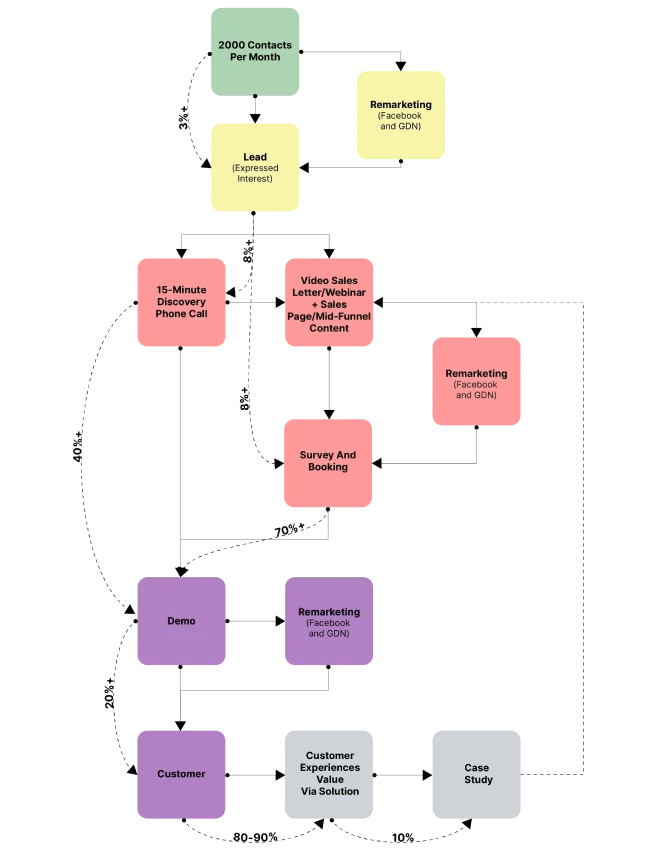
Outbound Prospecting and inside Sales
Pros:
Inexpensive
Fast to set up
Easy to duplicate
Cons:
Hard to scale
Expensive to scale
Uses Cases:
Testing out new offers
Selling tickets with a gross contribution of more than $5k
When you know who you’re targeting
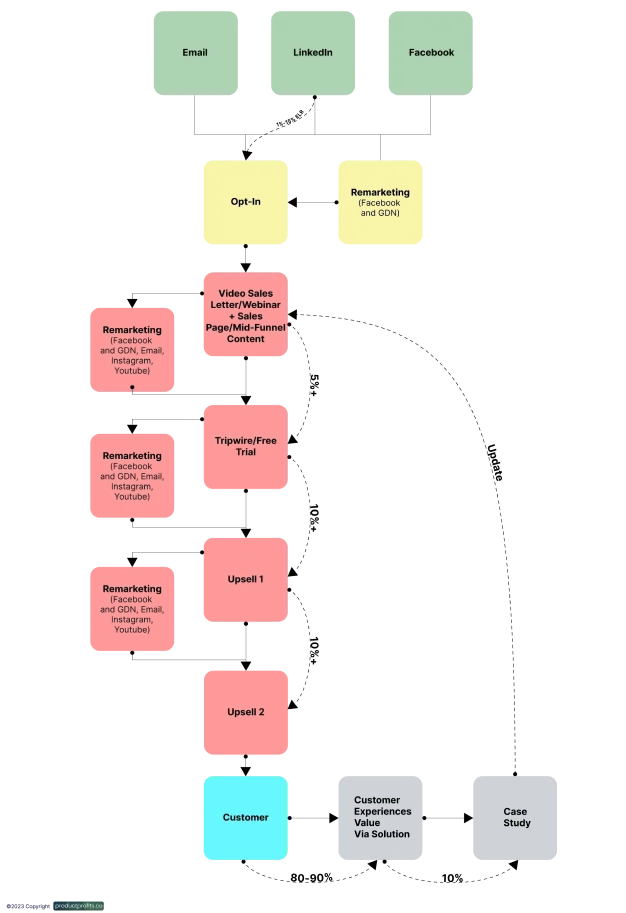
Automated prospecting with an Automated free trial
Pros:
Allows you to scale
Quickly test new offers without risk
Extremely cost-effective ($200 per month)
You don't need to hire a sales team
You can keep your team small
Cons:
Requires continuous maintenance
Requires fine-tuning over extended periods
Slow to set up
Uses Cases:
When you want to test new offers quickly
When you are generating your first use cases
Customise your content and messaging to align with each stage of the funnel.
Step 2 - Isolate Your Niche and build decision-maker contact lists
Gone are the days of casting a wide net to capture leads. Today, successful B2B lead generation strategies thrive on precision.
Identifying your niche involves zeroing in on a specific subset of your target market. If you want to isolate your niche, start with thorough market research.
Construct detailed customer profiles or buyer personas. These profiles should encompass demographic details, pain points, objectives, and challenges they are facing. You will need to list all of their ideals “before’ and “after states” and to ensure that you understand your target market deeply, perhaps even more profound than they know themselves.

Honouring a laser-targeted niche will enable you to create marketing messages that speak directly to your target customer and send chills down your prospect's spine. It would help if you focused on selling to one niche and then expand in concentric circles like the diagram here.
Step 3 - Create Messages That Resonates With Your Customer
Now that you've pinpointed your niche, it's time to create a message that truly connects with your target audience. Your message shouldn't grab their attention but form a genuine bond. Take the insights you've gathered from customer profiling to identify the main issues your audience faces. Then, you can build your message around the offered solutions.
But how does your product ease their pain points and help them achieve their goals? And here's the key – keep it clear and straightforward. There is no need for fancy jargon or complex language. Your audience should instantly understand what you're offering and why it matters to them.

Figure 1: A message with the same wavelength as your customers will result in resonance. Broadcasting these messages will excite your customers to speak with you.

Figure 2: A message with the wrong wavelength achieves no resonance in the market. Broadcasting messages to your customers on this wavelength results in apathy and disconnection.
The whisper test. Your marketing message should be attractive enough to your prospects that even if you were to whisper it to them while they were sleeping, they would wake up excited.

Step 4 - Turn the Message Into a Sales Letter
Now that you've got a message that clicks with your audience, let's turn it into a persuasive sales letter. This letter is the core sales argument for your business. This is where you discuss your value and why your product or service answers their problems. The central idea of a sales letter is to ensure that everybody in your business is singing from the same hymn sheet and agrees on the same sales message.
Theoretically, you should only send your prospect the full written sales letter in ANY format. You can send a handwritten sales letter, a Google Doc, or other means. Remember, your sales letter should include essential information to move your prospect from the cold to the buying stage. And therein lies the true power of the sales letter. You can find many tested formulas for writing a sales letter that has existed since the dawn of marketing.
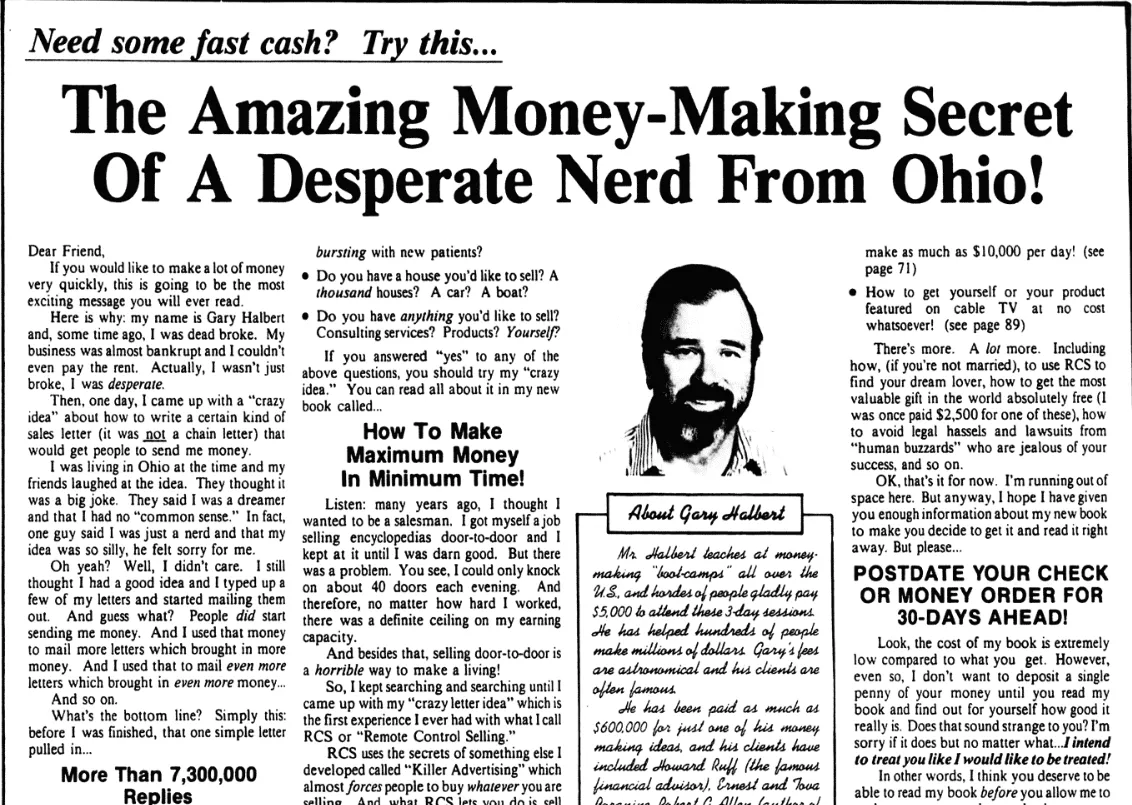

Step 5 - Echo Sales Letter Through Sales Assets
Once you create a sales letter, break down the message across different areas of your sales funnel and repurpose it into other sales assets in various channels. This includes blog posts, infographics, explainer videos, webinars, or podcasts—all carrying the same core message.
The sales funnel becomes easy to construct once the master sales letter is written. Everything is derived from the sales letter. For example, the website's homepage hosts the sales letter.
The outbound messaging templates are derived from elements of the sales letter, sales assets, and offers. Even the webinar is just the sales letter in video format. So, when you echo your message through multiple sales assets, you're casting a wider net and catering to diverse learning styles.
Fascinating history of sales letters
The history of sales letters is older than the Internet. A sales letter serves as the cornerstone of direct mail marketing campaigns. Traditionally, marketers would send out physical magazines or brochures with meticulously crafted sales letters to influence the reader to purchase. Often, sales letters featured a unique code that interested consumers could use to order the product or service.
With tracking codes, it became possible for marketers to gauge the effectiveness of different sales letters. It also allowed marketers to refine their approach over time. This early form of A/B testing laid the foundation for sophisticated, data-driven marketing strategies. The sales letter has evolved with technology, but its persuasion and direct response principles remain as relevant as ever.
Step 6 - Create and Launch your Outbound Campaigns
Build a list of 2000 - 5000 decision-makers.
We use Seamless or Apollo. Ensure the decision-maker list is cleaned and they are precisely who you are targeting. Feed the decision-maker list into your automated LinkedIn prospecting system or email marketing system.
Monitor responses and fix each of these metrics as it becomes a problem.
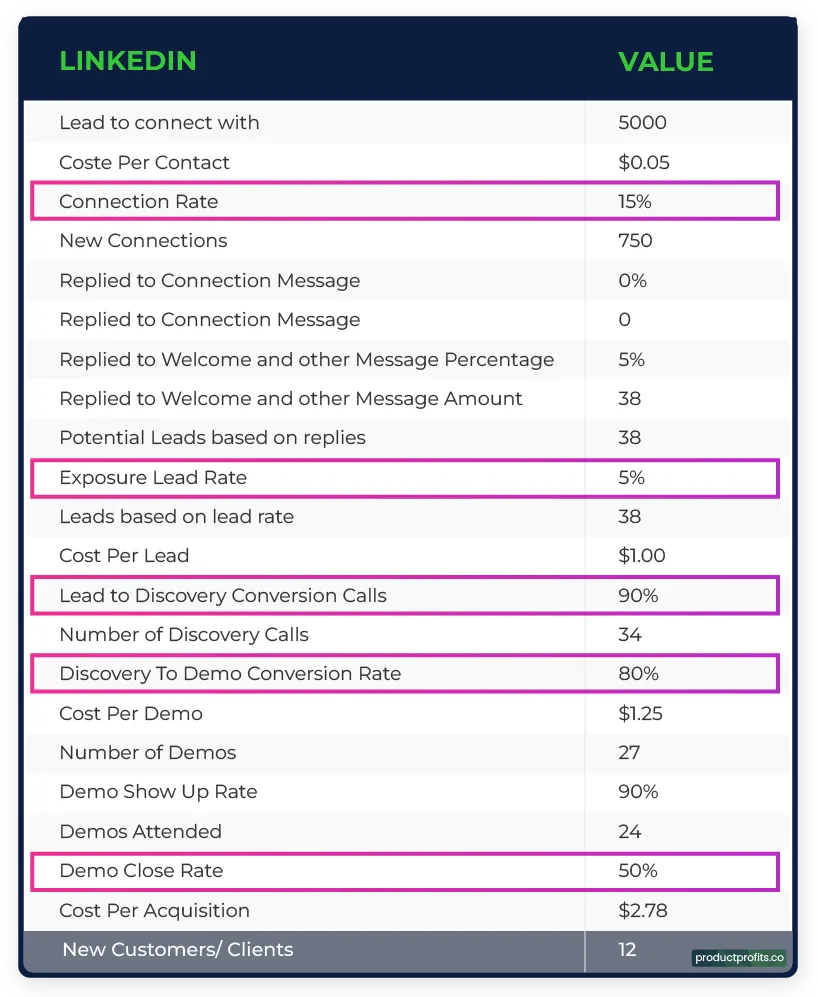
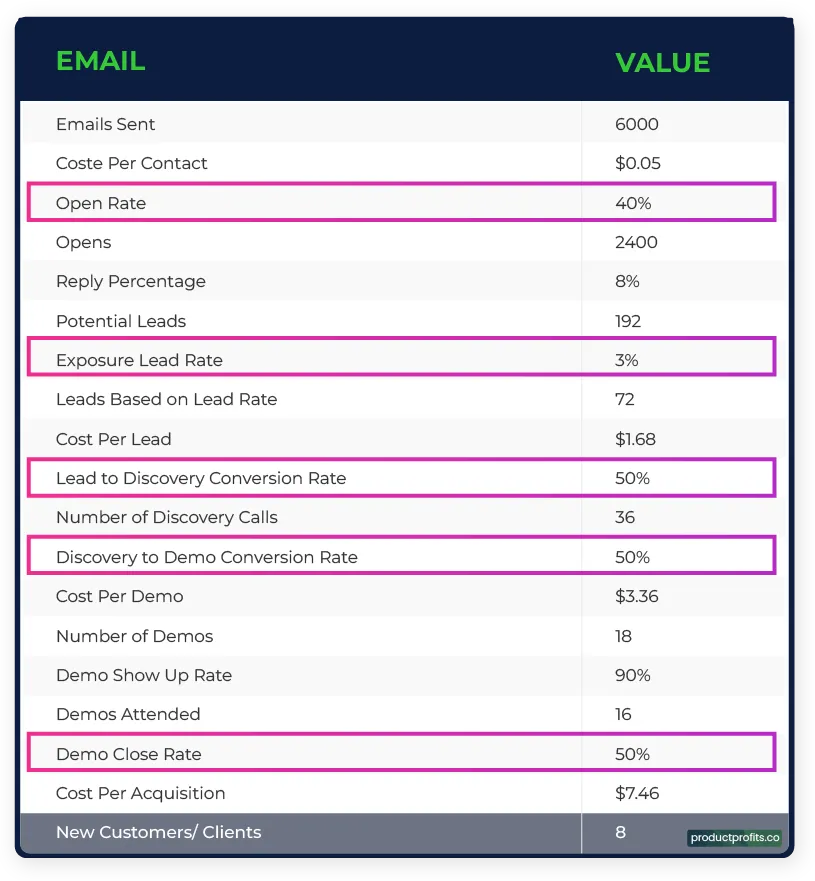
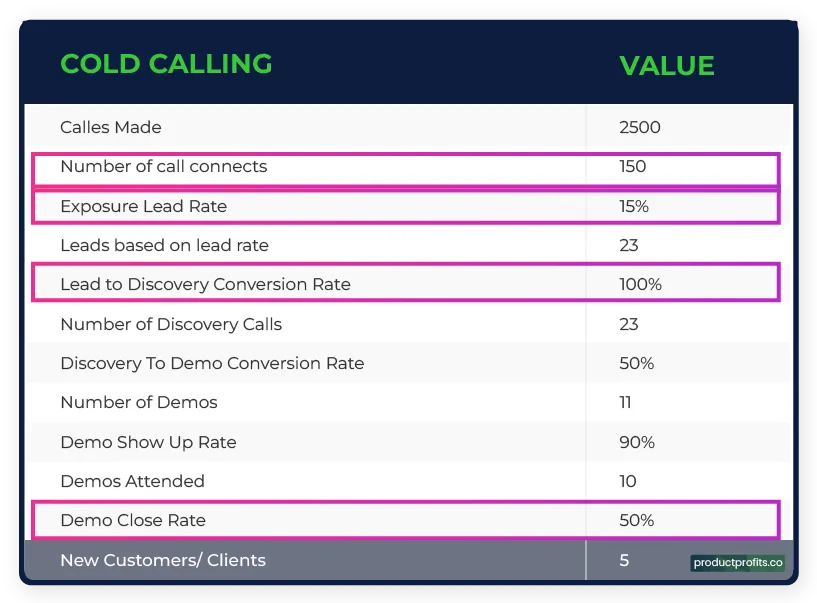
If the LinkedIn connect rate is a problem, optimise your profile and messaging
If the exposure lead rate is a problem, test different messages
If the discovery to conversion rate is a problem, implement a more rigid appointment booking process.
If the close rate is a problem, optimise your demos, and bring in Product Profits to help close some deals for you.
Step 7 - Automate, Template, And Streamline As Much As Possible.
If you want those leads to flow smoothly, you must make the most out of automation. Create templates for emails, follow-ups, and social media messages. These templates should be adaptable to suit different segments of your target audience. Use automation to schedule these communications at optimal times. Most Importantly, ensure consistent engagement without manual effort.
Next, streamline your lead nurturing process. Set up triggers that automatically send follow-up emails when a lead takes action on your site or social media.
Efficient automation saves you time and ensures you take advantage of golden opportunities.
To ensure efficiency, you need ten email sequences pre-written and templated in your business.
Implement contingency plans to stop leakage in your sales funnel.
Your sales funnel is like a bucket with tiny holes. Those holes are where leads sometimes slip through. Opt for follow-up sequences if you don't want to deal with this situation.
A great strategy is email sequences. It starts with a friendly nudge, reminding leads of their first encounter, and gradually turns up the persuasion dial. These emails should be strategically timed to re-engage leads who might have lost interest.
Next, segment your audience based on their interaction with your content and emails. Tailor your contingency sequences to their unique needs. For example, send them deep-dive content if a lead is about a specific product feature.
Remember, the goal is not just to revive interest. It's about giving them extra value and answering their burning questions.
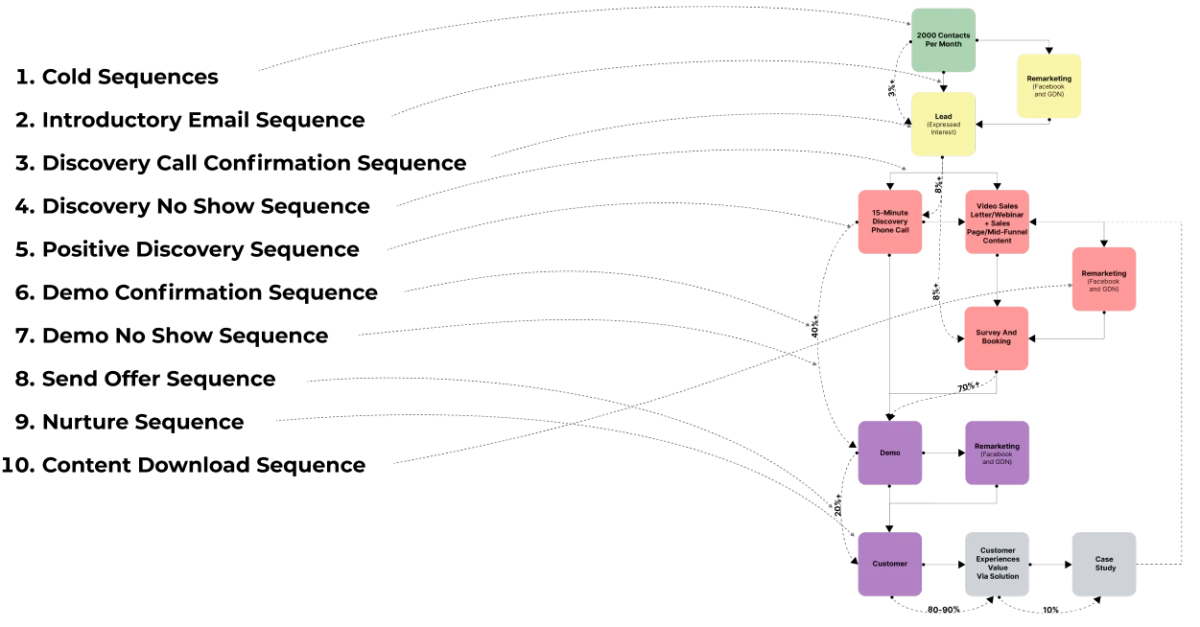
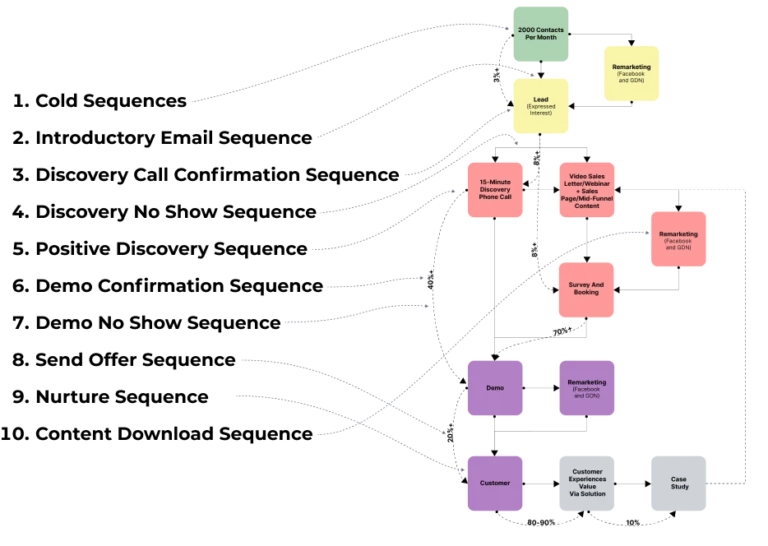
Total of 10-20 hours of content and nurturing just through automated sales alone!
Options for Implementing a Lead Generation Strategy
Now that you've got the lowdown on what an organic lead generation strategy is and why it's crucial, let's break down options for implementing one.
Hire A Marketing Agency Or Lead Generation Agency
If you're launching a brand-new business or product, hiring someone other than a salesperson or an entire team would be wise.
Pros/Cons:
You can lighten the load and, let's admit it, some stress.
Lead generation agencies often follow the "pay-to-spray" approach, which could result in your target market getting bombarded with not-so-great messages. That's a big no-no for your brand.
Surprisingly, lead generation and marketing agencies often need help generating leads.
It can get expensive; if it doesn't work out, you're back at square one.
Figure Things Out On Your Own:
You can go solo if you're a hands-on entrepreneur who knows your product inside and out. However, brace yourself since it will take much work.
Pros/Cons
You'll save some bucks by not hiring external help.
Managing everything yourself, especially with investors breathing down your neck, can be overwhelming.
You'll need to invest much time learning the ropes, experimenting, and potentially making costly mistakes.
Partner With Product Profits
No holding back. We'll give you all the know-how we've gained over 15 years of hard and passionate work in the B2B lead generation space.
Pros/Cons
We've been in the trenches for 15 years.
You'll get the know-how of the hundreds of tests we've made in the past.
We have a 100% success rate in building lead-generation machines for our clients. (We don't like to brag, but our track record speaks for itself.)
Believe it or not, there's no "cons" section here. Okay, maybe we're biased because we believe in what we do.
State-of-the-Art Lead Generation:
The Product Profits 4P Approach
If you want leads to knock on your door while focusing on doing what you love, the Product Profits 4P approach couldn't be more perfect for you. It is a proven method that helps B2B businesses snag top-notch leads and confirm their market fit. It is a beneficial approach if you don't have a background in sales or marketing.
Here's how it breaks down:
The Product Profits 4P Approach
Pinpoint: Start by building a list of 2,000 decision-makers who fit your target niche, psychographic, or demographic. This is your goldmine for potential customers.
Present: Develop 5-10 different transformation messages. Think along the lines of, "We help [niche] achieve [biggest desire] without [biggest obstacle or pain point]."
Process: Load these potential customers into the Product Profits Prospecting System.
Parse: This is where the rubber meets the road. We generate leads and put meetings on your sales team's calendar. Sales support in the box.
Once you implement our 4P approach, we will install lead generation systems in your business that constantly generate a steady stream of warm leads.
Lead Generation Services
Do It Yourself (DIY)
You access our minds and "steal" our 15-year know-how. You'll get all the tools, scripts, and training you need to generate leads. All for a modest initial setup fee of $2,000 + $200 per month in software costs.
Why Choose DIY?
Cost-Effective: This is a budget-friendly alternative to hiring a full-time Sales Development Representative (SDR).
Time-Saving: As a founder or product owner, your time is precious. Our automated system takes care of the initial outreach, freeing you up to focus on other crucial aspects of your business.
Fearless Prospecting: Automation removes that intimidating factor, especially if you're a founder with no sales background.
This is ideal for hands-on founders who want to make a big splash in the market… while remaining budget-conscious.
Done With You (DWY)
It's a partnership where we work side-by-side to build and fine-tune a lead generation system that works. We'll do the work, and you'll harness the results.
For a one-time payment of $10,000 or three monthly fees of $4,000, you'll get:
One-on-One Sessions: Personalized guidance tailored to your unique challenges.
Sales and Demo Call Support: We'll be with you during these critical interactions, ensuring you put your best foot forward.
6-Month Free License to Muscle CRM: Our proprietary CRM software will be your command centre for sales and marketing.
Full Lead Generation System Installation: We'll create a complete sales and marketing system customised to your needs.
Why Choose DWY?
Expert Guidance: It's not just about saving money; it's about making savvy investments. We'll be your guide, making sure you seize every opportunity.
Exclusive Tools: Gain access to our proprietary software, Muscle CRM. Get our seasoned sales team to back you up during those all-important sales and demo calls.
This package is for companies itching to hit the ground running and ready to shake things up in B2B lead generation.
Ready to get hot leads straight to your door?
Real-World Lead Generation Case Studies
SoftwareX is a Washington-based software and consulting provider. Within 30 days, we generated 450+ replies from LinkedIn with over 160 leads! These leads are a mix between the top and bottom of the funnel, with some suited to the consulting offer and some to the SaaS offer.


These results were higher than initially expected; as a disclaimer, these are not typical.
To be more certain about our skills, check out the results below in one of the world's most oversaturated B2B markets. Our client is an offshore software development company.
(how many of these do you get reaching out to you regularly?)
We consistently generate six leads per month, with a baseline of 4 leads per month, average months ranging up to 10 leads, and a lead value of $35k-$600k.
August 2022 - 6 leads
September 2022 - 4 leads
October 2022 - 8 leads
November 2022 - 11 leads
December 2022 - 7 leads
January 2023 - 17 leads
February 2023 - 11 leads
March 2023 - 4 leads
April 2023 - 5 leads

Frequently Asked Questions About B2B Lead Generation
What's the Difference Between B2B and B2C Lead Generation?
B2B focuses on attracting other businesses or professionals as clients. Simultaneously, B2C aims to engage individual consumers. B2B lead generation often involves longer sales cycles, complex decision-making processes, and personalized, solution-driven approaches. B2C lead generation tends to be more transactional, emphasizing mass marketing and immediate sales.
How long does it take to see results from B2B lead generation efforts?
You can look at lead generation through the lens of a marathon rather than a sprint. It can take some time before you can see solid results. After all, building trust and relationships with potential clients takes time. It can, but it's not usual. Still, it's paramount to be patient and consistent.
What Role Does a Lead Generation Specialist Play?
A lead generation specialist crafts and implements strategies to attract high-quality leads. These experts also collaborate closely with the marketing and sales departments to align efforts.
What should I look for in a B2B lead generation specialist?
When choosing a lead generation service, consider their industry experience, track record of success, and understanding of your target audience. Also, look for transparency in their methods and pricing. A good agency will customize its approach to fit your needs and goals.
How do I measure the success of my B2B lead generation campaigns?
You can measure success through various metrics, like conversion rates, click-through rates, lead-to-customer conversion rates, and return on investment (ROI). So, set clear objectives and track these metrics to assess the effectiveness of your campaigns.
What are some common mistakes to avoid in B2B lead generation?
Common mistakes include:
Neglecting lead nurturing.
Not segmenting your audience.
Using generic messaging.
Buying low-quality leads.
Failing to follow up with leads promptly.
You'll get significantly better results if you avoid most of these pitfalls.
Are Traditional Methods of Lead Generation Still Effective in 2023?
Traditional lead generation methods, like cold calling and direct mail, still have their place but may not be as effective as they once were. Today, consumers and businesses are more digitally oriented. Online strategies, such as content marketing, social media engagement, and email campaigns, have gained prominence.
How Can AI Improve Lead Generation Strategies?
AI-powered algorithms can identify patterns in customer behavior, helping you target prospects more effectively. Chatbots and AI-driven customer support can engage leads in real time. Additionally, AI can optimize marketing campaigns by refining ad targeting and predicting customer preferences.
How Does Social Media Aid in Lead Generation?
Social media is a powerful tool for lead generation because it lets you personally connect with potential customers. The trick is to share valuable content, engage in conversations, and build relationships to attract and nurture leads.
Is it better to buy leads or generate them organically?
Organic lead generation is usually better in the long run. Buying leads can be risky since there's a good chance of questionable quality, which hampers your reputation. On the other hand, organic leads are genuinely interested in what you offer. Consequently, it increases your chances of conversion.
Are there any tools or software that can help streamline B2B lead generation efforts?
Yes, many tools and software are available to streamline lead generation, such as CRM (Customer Relationship Management) systems, email marketing platforms, marketing automation software, and lead scoring tools. These can help you manage, nurture, and track leads effectively.
How do I comply with data privacy regulations like GDPR and CCPA in my lead generation efforts?
Ensure you have explicit consent before collecting and using personal data to stay compliant. Provide clear privacy policies, allow opt-outs, and regularly update your practices to remain compliant. Part of the process is to keep up with changing regulations. It is crucial to value data privacy to maintain trust with your leads.
